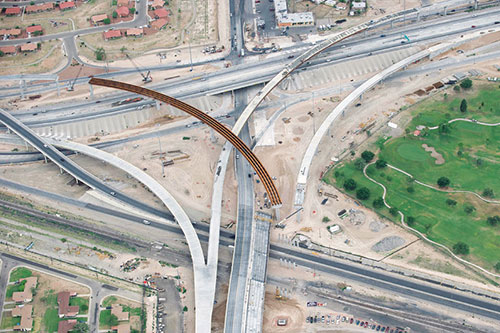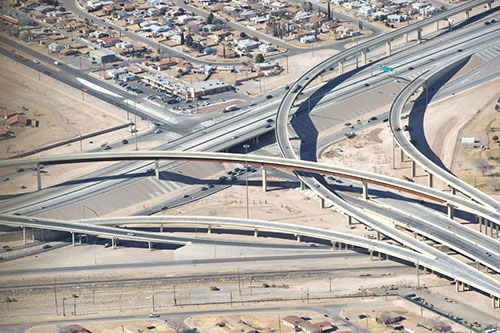GOMACO World Index --- GOMACO World 39.1 - March 2011
C-450 Flies High on the Spur 601 Project
J.D. Abrams is using their GOMACO C-450 to finish the direct connectors on the massive Spur 601 Project near Fort Bliss in El Paso, Texas.
The Spur 601 Project in El Paso, Texas, was unique for several reasons. It was a design/build project for a 7.5 mile (12.1 km), six-lane highway on the eastern side of the city. The new road will connect U.S. Highway 54 on the western edge, to the Purple Heart Memorial Highway (Loop 375) on the eastern edge, which will improve access to the U.S. Army's Fort Bliss and to the city of El Paso, including international ports of entry to the area.
The El Paso Master Transportation Plan reported this northeastern area has one of the highest growth rates in the city. Also, the U.S. Department of Defense will increase troop size at Fort Bliss by 50,000 as part of their Base Realignment and Closure activities. Soldiers commuting to and from the base need a route to get there from the city quickly and efficiently.
Traditional funding for the massive project would not be readily available for another five to 10 years. J.D. Abrams L.P., an El Paso based developer, came forward with a design/build proposal with themselves as the contractor, and arranged for the financing of the project. The Texas Department of Transportation (TxDOT) accepted the innovative proposal and allowed construction to move forward. It's the state's first private-sector, pass-through financing agreement.
This is how the pass-through financing agreement works. TxDOT provided $55 million during the construction phase: $45 million in federal highway funds and $10 million from the city-owned El Paso International Airport. Abrams worked with the Camino Real Regional Mobility Authority to sell bonds to finance the project. The state of Texas is reimbursing J.D. Abrams from the state transportation fund with payments based on the total volume of traffic generated by the highway.
It is not a toll road and the state will not collect tolls. TxDOT will count the total volume of traffic on a daily basis and pay Abrams back based on the number. Once completed, TxDOT will make payments for 10 years, with a $35 million per year cap.
"The project was absolutely massive," Brian Chaffe, Structure Superintendent for Abrams, said. "For any company to take on the liability of a $367 million project is pretty rare. During the early design phase, we had 100 designers working in our offices here in El Paso, and during the bulk of the construction between 250 to 300 workers and 33 foremen were on the project. It was a lot to coordinate."
Chaffe and his crew's main area of concern was an elevated six-lane section that stretches from Chaffee Road to U.S. 54.
"The main bridge on this stretch at its widest point was 144 feet (43.9 m) and at its narrowest was 118 feet (36 m) wide," Chaffe said. "It's a monster with 53 spans, two on/off ramps and four direct connectors. One of the direct connectors involved 22 spans, 80 to 90 feet (24.4 to 27.4 m) in the air. To look at it from the air, it looks like a squid with four tentacles and there's nothing straight. We didn't have any simple, straight pours."
Abrams brought in their GOMACO C-450 bridge deck finisher to work on the direct connector portion and also on other areas on the project. Their C-450 was working 30 feet (9.1 m) wide and finishing four inches (102 mm) of concrete on top of four inch (102 mm) precast concrete panels, forming an eight inch (203 mm) thick concrete deck.
Strict concrete specifications required most of their bridge pours to take place at night in the cooler Texas temperatures. Before any pour took place, Abrams' surveyors fine-tuned the C-450's rail. The C-450 completed a dry run over every panel making sure everything was in exact alignment and the correct deck thickness was maintained.
The project required a Class S, 3600 psi (25 MPa) concrete mix capable of achieving a four-day strength of over 4000 psi (27.6 MPa). Concrete had to arrive at the site at a temperature of less than 85 degrees Fahrenheit (29º C), but higher than 50 degrees Fahrenheit (10º C). And if the concrete was too hot, it had to be doused at the plant with liquid nitrogen to cool it.
Once the concrete reached the job site, a local pumping company used their 58 meter (190 ft) pump to place the concrete up to the deck. Concrete slump averaged between 5.5 to six inches (140 to 152 mm).
Several challenges in the bridge deck pours created added difficulty, with 15 degree skews that straightened over a series of spans, bridge beam deflections, 2.5 inch (64 mm) crowns that shrunk down to zero, and widths varying in the same span.
"In one span, we had a crown that didn't match up to either side... a trapezoid pour with a crown down the middle of it," Chaffe said. "Our C-450 has horizontal alignment and the ability to widen or retract to match the changing width. It's really a great machine for us and we ask a lot from it, especially on this project.
"My advice to project engineers is simple. Don't skew the span if you don't have to and don't make the width of the span change if you don't have to. Everything else isn't really going to bother us."
Production on the bridge spans averaged 70 cubic yards (53.5 m3) per hour, with the best production reaching 102 cubic yards (78 m3) per hour.
"After so many pours and so many square feet of deck production, it got to be like clockwork for our guys," Chaffe said.
As construction progressed, different phases of the Spur 601 project were opened up to the public. Abrams was given a 41-month schedule to obtain right of way, relocate utilities, and design and build the project. They finished on time on January 28, 2011. The state has already made their first payment to Abrams, and will continue semi-annual payments until January 2020.
Subscribe to Receive GOMACO World Magazine

